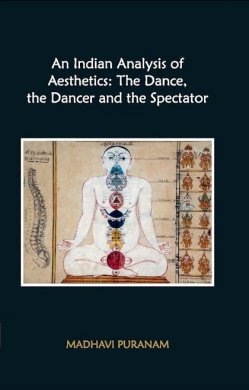
|   |

|   |
|
‘An Indian Analysis of Aesthetics: The Dance, the Dancer and the Spectator’ by Madhavi Puranam - Nita Vidyarthi e-mail: nitavidyarthi@gmail.com May 13, 2016  The book ‘An Indian Analysis of Aesthetics: The Dance, the Dancer and
The Spectator’ is a scholarly attempt and inspirational insight into the
world of aesthetics primarily in the traditional Indian classical
context. The author has placed philosophy, psychology, for that matter
emotions and sensations lying therein and perception of beauty of other
civilizations and countries alongside at the beginning (Chapter 2) of
the seven chapters with a rich bibliography and an explicable glossary
at the end. This makes for comfortable reading of the otherwise heavy
subject. The preface is the appropriate foreground to manifest the
critical mind of the author and the treatment of the subject
subsequently and so it goes to show that the author is necessarily and
knowingly both the writer and the reader. This is articulated in Chapter
1 “Enquiry”- the proof of the question is in the answer. The book ‘An Indian Analysis of Aesthetics: The Dance, the Dancer and
The Spectator’ is a scholarly attempt and inspirational insight into the
world of aesthetics primarily in the traditional Indian classical
context. The author has placed philosophy, psychology, for that matter
emotions and sensations lying therein and perception of beauty of other
civilizations and countries alongside at the beginning (Chapter 2) of
the seven chapters with a rich bibliography and an explicable glossary
at the end. This makes for comfortable reading of the otherwise heavy
subject. The preface is the appropriate foreground to manifest the
critical mind of the author and the treatment of the subject
subsequently and so it goes to show that the author is necessarily and
knowingly both the writer and the reader. This is articulated in Chapter
1 “Enquiry”- the proof of the question is in the answer.As a result of the curiosity and onus for appreciating and enjoying the beauty of dance or the aesthetic pleasure, the author has journeyed through a number of treatises as mentioned in Chapter 1 and tried to investigate the possible relation between the “mechanism of spectatorship that is being propounded in the Sarira vivika,” explained and discussed in detail later in Chapter 6. The ground for the mechanism of appreciation of music and dance is gradually prepared through an appropriately illustrated Chapter 3 – Rasa: The Sentiment - with photographs of the Kathakali maestro Kalamandalam Krishnan Nair. Chapter 4 is a compact account of the Sangita Darpanam written by Chatura Damodara. Then comes the enriching ‘Yoga and Sahaja Yoga’ in Chapter 5 with photographic plates of “Proto Shiva” from the Directorate of Archaeology and Museums, Sindh, Pakistan (which is rare) followed by paintings of chakras, Shat Chakras showing the place of the chakras in the human vertebra and their governing deities. This chapter speaks of the competence of the author in grasping, then treating and putting down the difficult subject lucidly without any confused alternatives to explanations. The function and description of the three nadis as described in ‘Sahaja Yoga’ has been explained with care and clarity. There are diagrammatic representations and details of the Chakras and the nadis but the crowning glory is the table on page 165 showing the summary of Chakras and the corresponding “Bija aksharas, Bija mantras, Svaras and ragas.” This is at the destination of the book in Chapter 7, the final one which also has interesting comments on the mystical symbolism associated with the mythological forms and epics like why does Krishna or Shyam mean dark, and others. Chapters 5, 6 and 7 have the most insightful piece of information. The book is illustrated with the photographs of stalwarts like Balasaraswati, Kelucharan Mohapatra, Shambhu Maharaj, M.S. Subbulakshmi, Bismillah Khan, Ravi Shankar and many more. The cover is a dignified black jacket with an attractive printed picture of Shat Chakras, Tanjore, India, on it. The foreword by Dr. Kapila Vatsyayan is a real asset. The ambitious attempt speaks of a lot of research and hard work. Madhavi Puranam has put forward the view that the study or principals of aesthetics for that matter art is self-expression, pure and simple and the transcript of personal feeling and experiences is realized through a physical, meta-physical, spiritual and scientific (anatomical) mechanism of the human body or rightfully psyche. The transition from Chapters 6 to 7 could have been more detailed and elaborate for easy comprehension, the subject being so intense, deep and intellectually intense especially for those with conflicting ideas or with no ground work at all. But it is a collector’s item and a book worth possessing. Abhinav publications, New Delhi Jacketed Hard Bound 232 Pages Price: Rs 900 ISBN: 81-7017-555-0 Dr. Nita Vidyarthi is a regular contributor to The Hindu and the Statesman Kolkata in dance, vocal music and theatre. She is trained in Kathak, Bharatanatyam and Manipuri as well as vocal, semi-classical music and Rabindra Sangeet. A Science communicator, Ph.D. in Polymer Science, Commonwealth Scholar and a retired Professor of Chemistry, Nita devotes most of her time to dance and theatre writing. Post your comment Unless you wish to remain anonymous, please provide your name and email id when you use the Anonymous profile in the blog to post a comment. All appropriate comments posted in the blog will also be featured in the site. |